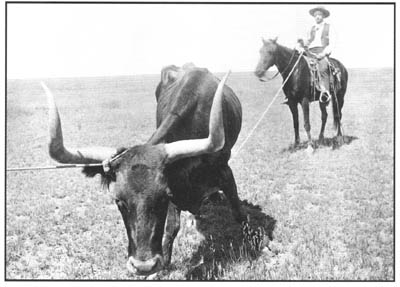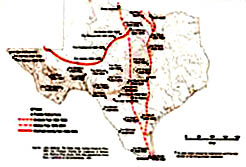Intercultural
Conflict of the
Cattle Industry

Picture taken from In the Days of the Vaquero (Freedman, 49).
Origin and Growth of the Ranching Industry
The foundation for the ranching industry in Texas sprang from the large
number of cattle that existed in northern Mexico, roaming the open range.
The first cattle were brought to the new world by Gregorio de Billalobos
along the Panuco River in 1521 six months before Cortez captured Mexico
City. The herds eventually spread northwards into present-day United States
(Alonzo, 74). These cattle, a combination of three different breeds of
Spanish cattle would become the famed longhorns, which spread through
the coastal plains of Texas (Monday, III). The wide, open grazing land
in northern Mexico and the southwestern United States was ideal for the
large scale grazing and proliferation of the population of cattle, horses,
sheep, mules and goats. Missions were the first institution to encourage
the livestock industry in northern Mexico, where local indigenous people
were encouraged to raise domestic animals (Alonzo, 74). Around the turn
of the 18th century the industry began establishing itself in the form
of ranches in Mexico, New Mexico and Texas. Ranching, farming and trading
of livestock became the primary economic activity in the area due to lack
of other valuable resources such as silver, or other mining industries
(Alonzo,74). By 1748 ranches had been settled along the Rio Grande River
as a line of defense against Indian attack. Eventually permanent Mexican
settlements would be established in territory that Mexico would be forced
to hand over to the United States after the Mexican-American War. Between
1750 and 1848, large numbers of settlers received land grants from Spain
and, later, Mexico in this territory between the Rio Grande and the Nueces
River (Alonzo 3). Their settlement marked the beginning of a livestock
trade in Texas that has persisted until today.
The people who occupied this disputed territory had been exposed to a
long tradition of intercultural conflict. This conflict in the Lower Border
has, in large part, dictated the growth and success of the cattle industry
in Texas. In 1821 Stephen F. Austin and a group of settlers came to Texas,
and would create the market for what would become a mammoth cattle industry
(Acuña, 7). The Texas-Mexico War of 1836 led to an increase in
number of wild cattle. Ranchers in the area were too preoccupied with
war to instigate large round-ups or settlements, and cattle were left
to prosper on the open plain. Before 1848, the Valley of the Río
Grande was home to thousands of cattle (Acuña, 27). Economic life
in the Lower valley was based on agriculture, of which the cattle industry
was a substantial part. Tejanos were “entrenched in a rural society,
while Anglos…dominated the towns (De León, 50). During this
time, some trade did develop between the lower valley in Texas and New
Orleans (Everett 24). By 1850 Brownsville, right across the border from
Matamoros, had developed as a trading center, which subsequently drew
the interest of Anglo-Americans (Acuña, 28). Due to the unregulated
nature of the trade at this point, there was always some sort of movement
across the border area. However, during the 1850’s U.S. merchants
ran Mexican merchants out of the Lower Valley. San Antonio in Central
Texas was another well-developed trading town with the largest Mexican
population of any Texas town. Many Anglos felt that Mexicans benefited
from their presence and “felt little qualms about taking their property”
through violent or coercive means (Acuña, 27).
During the first half of the nineteenth century, Tejano ranchos prospered
throughout the Lower Border and up into Central Texas, while Anglos developed
large ranch holdings in the Coastal Plains of Texas (Jordan, 83). Slave
labor was the primary source of labor on these Anglo ranches. After 1850
Anglos came to dominate the cattle industry in the area of Tejano settlement
as well. It came to be managed by "Anglo-American capitalists intent
on using the labor of Mexicanos" (De León, 50). After 1850,
the Mexican vaquero was the most typical laborer. This coincided with
the expansion of Anglo ranchers westward into areas of Tejano settlement.
By 1860, Anglo-American ranchers had taken over the cattle industry in
Central Texas and had turned it into a “grand-sized industry”
(Jordan, The Origin of the Anglo-American Cattle Ranching, 84).
By 1860, Anglo ranches had shifted westward into areas of Tejano ranching (Jordan, 84). Richard King and Mifflin Kennedy, owners of two of the most prominent ranches in south Texas were familiar with haciendas, or latifundios that existed in Mexico. These entrepeneurs were interested in creating an American version of the huge, highly profitable ranching and agricultural operations as well as the wealth, prestige and power that came with them. The partnership formed between the two men was much like the partnership formed may many Eastern entrepreneurs who were helping to create a new industial United States. The resulting ranches therefore resulted in a mixture of three cultures-Hispanic, Southern and Western (Monday, I) By 1860, Anglo-Americans dominated the Texas economy, which was based on the capitalistic endeavor of accumulating of land, resources, and cheap labor (Acuña, 30).
After the Texas-Mexico War and throughout the US Civil War, the cattle
industry did not grow significantly as many cattle reverted back to their
wild state due to constant conflict between Anglos, Mexicanos and Native
Americans (Everett 27). After the Civil War, the cattle industry entered
into its most prosperous stage. Southern and western cattle were probably
more desirable than cattle from eastern as more settlers moved west with
the frontier, which was a closer market and increased industrialization.
The Texas-Mexico War increased tensions in border area, further emphasized
racial divisions, as well as illuminating differing conceptualizations
of the land use.
In the words of one scholar,
The century or so of Spanish-Mexican rule (from the 1730's to 1848) saw the formation of a ranching and commercial society, one that built on continuities to the colonial heritage as well as adapting to new challenges in settling new lands, discovering opportunities in ranching and trade, and experiencing conflict with Indians and Anglos. (Alonzo, I)
Between this period and what Alonzo lables as the early American period
(1848-1900) is when the fist "Corrido de Kiansis" was collected,
as a product of the growth of the larger border-balled tradition (6).
This is time of adaptation and adjustment on the part of the Mexican,
as he struggles to form a new identity as a Tejano and a Mexicano: something
quite distinct from the previous colonial history in this unique historical
region of the southwest. The Chisholm Trail (cattle drives to Kansas).
[See link to Fig. 1 below] The Chisholm Trail was the path for the greatest
movement of cattle ever known. It was the central and most used of three
main cow trails through Texas used to drive cattle from South Texas and
Mexico up to Kansas markets from 1867-1884 (Gard, 56). It was said to
have been named after it's original founder, Jesse Chisholm from the North
Canadian River to South Kansas, however has also had the name the Kansas
Trail, Abilene Trail, McCoy's Trail, The Great Cattle Trail, Texas Cattle
Trail and Wichita Trail (Gard, 55). It overlapped with the old Shawnee
Trail that had been used during the 1840's which was just to the east
of the main line. Eventually, the Chisholm Trail overlapped with the Western
Trail that was formed later along with the movement of the US frontier
westward, roughly around1876. (Gard 56). Herds during this time came from
Texas, and from below the Rio Grande, driven by those who bought or stole
cattle and swam them across the border (Gard,57). From this point, cattle
trailed northward through Lockhart to Austin, or alternately through San
Antonio. Above San Antonio, feeder trails cam from each side. At Austin,
drovers took their cattle across the Colorado River, then across the San
Gabriel and Lampasas Rivers. The next stop was Fort Worth where they crossed
the west fork of the Trinity River, and were led north along the border
of Wise and Denton counties. The Red River, which was often flooded in
the spring, was the next large obstacle. However, once crossed, the trail
became almost straight following present-day Highway 81 to Abilene (Gard,
57). During the late 1870's, with increased growth, new markets in Kansas
opened up, primarily in Ellsworth, on the Kansas (Union) Pacific Railroad
line, and in nearby Wichita.
Fig.1
Map taken from Cultural and Historical Maps of Texas (Ellis, Jordan, and Buchanan, 25 ).
The invention of barbed wire in 1884 closed the open range, bringing a halt the legendary cattle drives (Gard, 60). As railroads became more developed and widespread, they eventually became the transportation of choice for the shipment of cattle from South Texas. Large ranches such as King Ranch (1854) and Kennedy Ranch (1860) were formed to adjust to the new economy of fenced ranches and shipments by rail (Monday I0). The growth and extension of the railroad into Texas would serve as another link between people of all sectors of the country as well as greatly influencing the life of the Mexican ranch worker.
